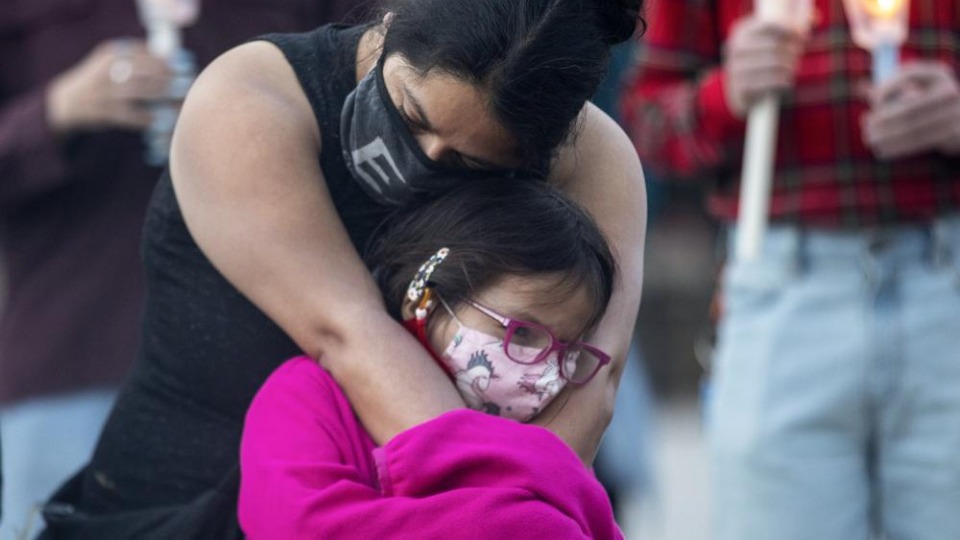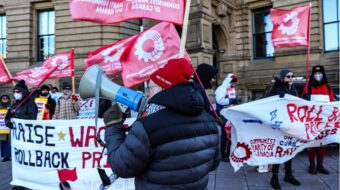
TORONTO—Indigenous communities across Canada and throughout North America are reeling following the disclosure last week that the remains of at least 215 children, some as young as 3 years old, have been found buried in a mass unmarked grave on the grounds of the former Kamloops Indian Residential School in British Columbia.
A news release from Tk’emlups te Secwépemc First Nation Chief Rosanne Casimir said the remains were confirmed in mid-May with the help of ground-penetrating radar. She said last Friday that more bodies could still be found, as there are several areas on the former school property that have yet to be searched.
The Kamloops Indian Residential School, which operated from 1890 to 1969, was one component of a vast Canadian government system aimed at eradicating Indigenous culture and identity. Over the course of more than a century, at least 150,000 First Nations children were taken from their families and communities and shipped off to state-funded Christian boarding schools; many never returned.
Authorities forced conversion to Christianity on the children, and they were forbidden from speaking their native languages. The schools were plagued by physical, mental, and sexual abuse, and as many as 6,000 children are estimated to have died while attending. The destruction of family and community ties interrupted the transmission of cultural knowledge and left survivors isolated and damaged.

As such, the schools also served to weaken collective resistance by Indigenous peoples to resource theft and land expropriation during the crucial years of Canada’s economic development. The residential school system was part of the effort to open up vast tracts of Indigenous territory for expanding Canadian capitalism.
From 1915 to 1963, documents for the Kamloops facility report 51 deaths, meaning the deaths of the overwhelming majority of the 215 children whose remains were found were never recorded. The Kamloops school was operated by the Catholic Church and funded by the Canadian federal government. Casimir says the discovery is proof of an “unthinkable loss that was spoken about but never documented.”
The findings have sparked calls for fresh examinations to be made on the grounds of every former residential school site across Canada. There were over 130 residential schools; the last one only closed in 1996.
The grave in Kamloops containing the children has not been exhumed, but Casimir said a full survey of the property and lands adjacent to it is expected to be finished by the middle of June. At that time, the information will be disclosed initially to First Nations tribes and bands before decisions are made on returning the remains to families.
Terry Teegee, the British Columbia regional chief for the Assembly of First Nations, told the press Friday that the discovery “resurfaces…the wounds” from Canada’s “legacy of genocide towards Indigenous peoples.”
A six-year investigation by the Truth and Reconciliation Commission of Canada concluded in 2015 that the residential school system amounted to cultural genocide. The commission was modeled on similar bodies established in Chile after the end of the murderous Pinochet dictatorship in 1990 and South Africa in 1996 following the abolition of apartheid.
The Canadian parliament tasked it with documenting the history and impacts of the residential schools; it heard testimony from over 6,500 witnesses and survivors. The TRC’s final report condemned the schools for the mass abuse they meted out, the erasure of children’s family and cultural traditions, as well as for the low quality of education and healthcare they provided.
The report supported claims long made by Indigenous leaders that the abusive and isolated existence experienced by children at the schools was a major factor explaining the epidemic rates of alcoholism, drug addiction, broken families, and economic underdevelopment seen on reservations.

The United States government oversaw a boarding school system similar to that operated in Canada over roughly the same time period; a few facilities still operate today. Like those in Canada, the U.S. schools were often run by churches and dedicated to cultural annihilation. Abuse was rampant, and overcrowding and poor funding led to repeated health epidemics and deaths.
As bad as the Canadian schools were, most experts conclude those in the U.S. were likely even worse, but no official government effort has been made to unearth and document the scale of the crimes committed. A short “Apology to the Native Peoples of the United States” was tucked into a 2010 defense spending bill. Still, it was short on details and denied any liability on the part of the federal government.
In Ottawa Monday, Canadian Prime Minister Justin Trudeau ordered flags lowered to half-staff in mourning for the 215 children. He said he was “appalled by the shameful policy that stole Indigenous children from their communities.”
Trudeau admitted that the cover-up of mass death at the Kamloops school was “not an exception or an isolated incident.” He said, “We’re not going to hide from that. We have to acknowledge the truth.” Trudeau was blunt about the nature of the cultural genocide perpetrated by the Canadian government in the past. “Residential schools were a reality—a tragedy that existed here, in our country, and we have to own up to it. Kids were taken from their families, returned damaged, or not returned at all.”
The acknowledgment by Trudeau of Canada’s past crimes is welcomed, but many say the government could be doing a lot more to address the legacy of its actions and stop ongoing oppression.
Kimball Cariou, the British Columbia provincial leader of the Communist Party of Canada, told People’s World that the Kamloops discovery was “absolutely shameful,” but that it was “not a new story, unfortunately.”
Cariou pointed out that among the 94 recommendations made in the TRC’s 2015 report was a mandate for immediate government action “to recover the names and full stories of all the children” victimized by the residential school system. But six years later, he said, the work is only beginning.

A statement issued by the B.C. Communists Monday said that the mass graves “tell the story of exploitation and genocide.” It called on the provincial government to take immediate action on behalf of First Nations peoples, including canceling controversial hydroelectric dam and natural gas projects. Speaking directly to Trudeau, the party demanded a “full-scale and complete accounting of all deaths in residential schools.”
Cindy Blackstock, who heads up the First Nations Child and Family Caring Society, said that the 215 children found in Kamloops are probably only the tip of the iceberg. The TRC has officially documented 4,100 Indigenous child deaths at the schools, but Blackstock believes the number is much higher.
“Many of these deaths were hidden,” she said. The government must “fully fund the work that needs to be done to identify the unmarked graves of children across Canada, because there are many, many more.”
“We’ve got governments at both the federal and provincial level that bend over backward to pour public money into energy companies looking to build pipelines or resource companies looking to mine on Indigenous lands,” Cariou told the World, “but somehow they can’t find the resources to bring finality and justice to Indigenous families and communities.”










